Monorail Modeling -
Puppy Mover Monorail
Page one of two
Model and Photos courtesy of James Horecka, January 2006 (updated May 2007)
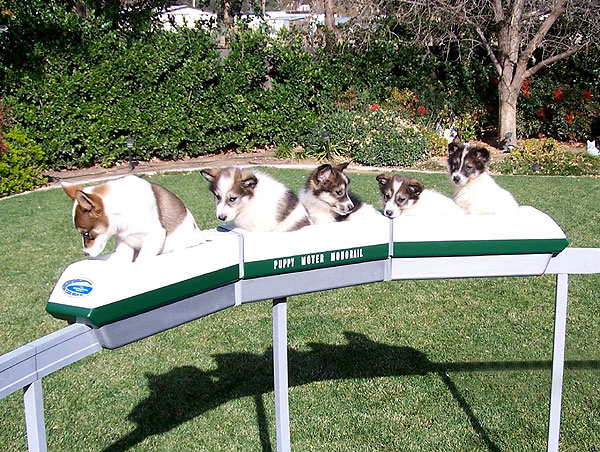
Behold, the Puppy Mover Monorail! This is certainly one of the most unique models we have ever featured, isn't it?
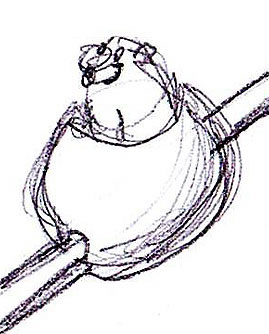 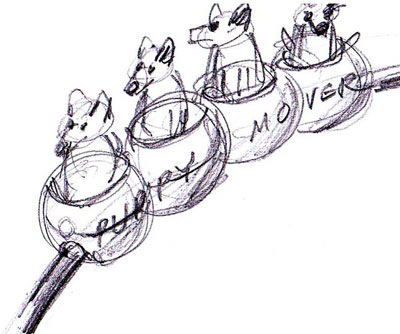
It all started as a joke idea from the whacky, yet creative mind of TMS member James Horecka, while enjoying lunch on a Friday afternoon. James thought it would be funny to make a PRT, or Puppy Rapid Transit vehicle, and send a picture to TMS headquarters for a laugh. Quickly the concept grew beyond a single car PRT vehicle into a monorail train full of puppies! By 3 PM that afternoon, parts were being purchased for the project.
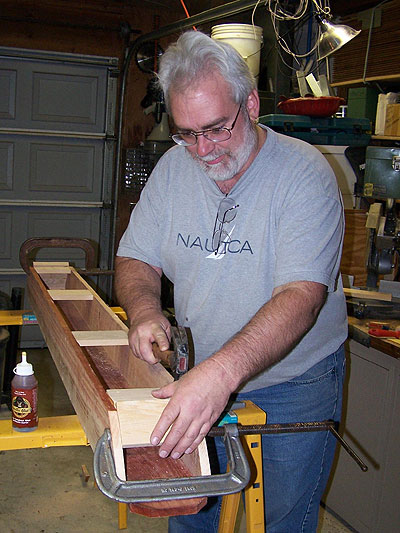
James is one of those rare people that actually takes his inventive ideas and builds something with them. That same Friday, from 5 PM to 10 PM, James built the entire train and track.
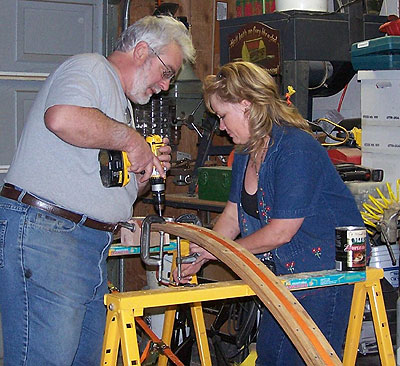
Here we are in the beam fabrication yard. That's funny, it looks very similar to the vehicle assembly plant, doesn't it? That's Shirley helping James laminate a curved piece of track.
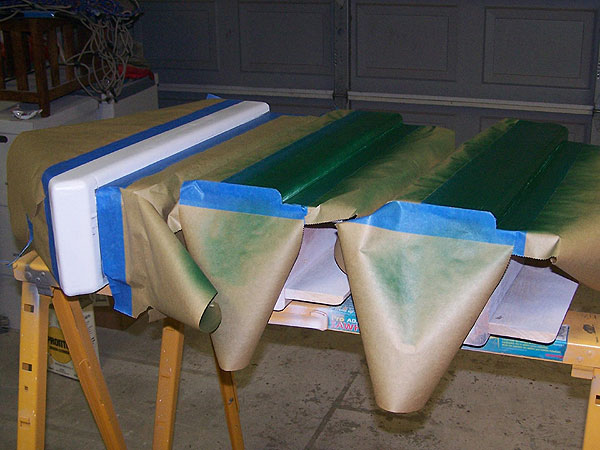
On Saturday the train went through an extensive painting process. As you'll see in James' own words below, on average the train has eight coats of paint!
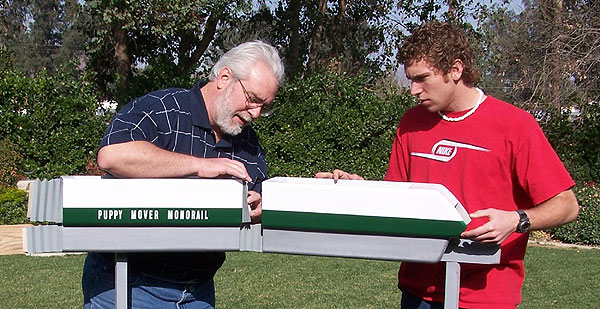
On Sunday lettering was applied to the train and time had arrived for the photo shoot. Volunteer Parker helps place one of the trains on the beam while bellows are attached.
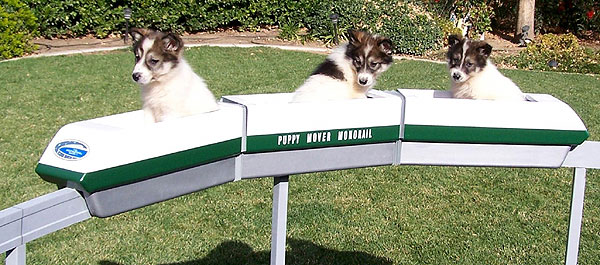
The photo shoot took place around noon on Sunday, a mere two days after conception! Native American Indian Dogs were put into place and voila, another famous monorail was born. This image shows minimal passengers per car, where the one at the top of this page shows crush-loading.
The following is a "How To" summary courtesy of the model's creator:
I threw the "Puppy Mover Monorail" together Friday and Saturday. I did it "Hollywood style" (only what would be "in camera" is finished. So the whole thing is pretty much a "prop." If you were to look at it from the back side, you'd see a few "boxes" made of scrap wood stuck atop a couple of stakes. The goal was to knock something out quick and dirty, stuff it with the last five puppies before they shipped out, and then shoot it (we started with ten puppies, now down to five, and they're gettin' bigger by the day). We have only two photos with the five puppies; the very first one was a hit. Here's a quick summary of the parts. It's basically just a few fence palings, some scrap wood and paint:
- Monorail train bodies: Total of three pieces of 1x6" x 6' long redwood dog-eared fence boards.
- Monorail train skirts: Two pieces total of 1x4" x 6' long cedar dog-eared fence boards. A third piece was used for the transoms.
- Bellows between cars: Cardstock (same as index cards, only 8.5" x 11" sheets), folded, hit with gray primer and stuck on with masking tape.
- Lettering: 1" vinyl "mailbox" letters (which I'd bought a few days before to letter my rural mailbox).
- TMS Logo: JPG image printed out and stuck on with a glue stick (used with permission of TMS).
- Beamway: Five pieces of redwood benderboard, left over from edging my rose garden in 1988, sprung into an arc with a nylon strap tie and then screwed together with pairs of drywall screws 4" o.c. (and a bunch o' screws near each end just in case).
- Pylons: Scrap 2x2s, 4' long each, ends pointed and driven into the ground. Only two faces were painted, of course.
- Miscellaneous: Scrap tin for connectors and such. Auto body filler. A couple of strips of bevel-cut mat board to trim the beamway. Various screws and such (mostly drywall screws, a few Tek screws, some pneumatic brads).
The concept sketches were laid down over lunch on Friday. They were pretty darn funny, so we laughed and went with it. All the basic design, fabrication and construction of the wood train and track was done after work on Friday. All painting was done on Saturday. About eight coats average, perhaps a dozen in some places. Lots of sanding, too, of course. Most coats of paint were quick-dry sandable primers (two types). The body is a gloss white enamel (two coats). The skirting is hammered-finish galvanizing paint. The accent stripe is gloss hunter green. Masking was done with a fast-mask tool (tape/paper combo). The camera angle was decided at the very beginning, before construction. So everything that would not show on film was left raw and unfinished. In fact, the "back sides" are pretty gnarly, including some cutting errors, a few piles of sheet metal shims, tape, thumb tacks, knot holes, cracked wood, crooked screws and even bent nails! This is similar to the techniques used for stage sets and props for film. These tricks cut total fabrication time to just a matter of hours.
James Horecka, AIA
Architect
April 2006 Update:
Puppy Mover Monorail grows!

Mr. Horecka has expanded the Puppy Mover Monorail to a larger five-car train. He's also added some track for the display. Here's a fresh batch of puppies onboard the new train. James tells us that it's quite an experience setting up a shot with "active" puppies!
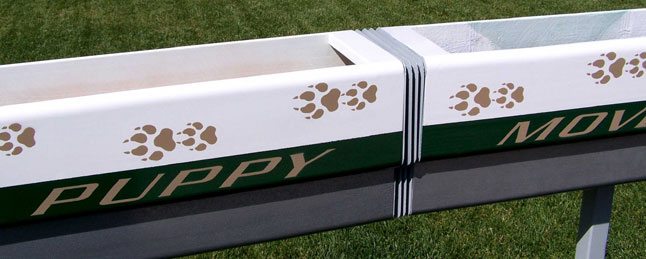
As always, James does quality work! Note the upgraded paint job detailing.
PAGE TWO: Puppy Mover Monorail Mark IV goes on the road
 / back to Modeling Page / back to Modeling Page
|









